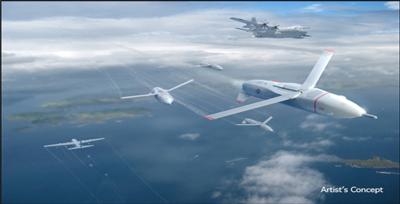Mon, Mar 27, 2017
Testing Ability To Recover Unmanned Aerial Vehicles On The Fly
DARPA recently completed Phase 1 of its Gremlins program, which envisions volleys of low-cost, reusable unmanned aerial systems (UASs)—or “gremlins”—that could be launched and later retrieved in mid-air. Taking the program to its next stage, the Agency has now awarded Phase 2 contracts to two teams, one led by Dynetics, Inc. (Huntsville, Ala.) and the other by General Atomics Aeronautical Systems, Inc. (San Diego, CA).

“The Phase 1 program showed the feasibility of airborne UAS launch and recovery systems that would require minimal modification to the host aircraft,” said Scott Wierzbanowski, DARPA program manager. “We’re aiming in Phase 2 to mature two system concepts to enable ‘aircraft carriers in the sky’ using air-recoverable UASs that could carry various payloads—advances that would greatly extend the range, flexibility, and affordability of UAS operations for the U.S. military.”
Gremlins Phase 2 research seeks to complete preliminary designs for full-scale technology demonstration systems, as well as develop and perform risk-reduction tests of individual system components. Phase 3 goals include developing one full-scale technology demonstration system and conducting flight demonstrations involving airborne launch and recovery of multiple gremlins. Flight tests are currently scheduled for the 2019 timeframe.
Named for the imaginary, mischievous imps that became the good luck charms of many British pilots during World War II, the program envisions launching groups of UASs from multiple types of military aircraft—including bombers, transport, fighters, and small, unmanned fixed-wing platforms—while out of range of adversary defenses. When the gremlins complete their mission, a C-130 transport aircraft would retrieve them in the air and carry them home, where ground crews would prepare them for their next use within 24 hours.
The gremlins’ expected lifetime of about 20 uses could provide significant cost advantages over expendable unmanned systems by reducing payload and airframe costs and by having lower mission and maintenance costs than conventional manned platforms.
(Image provided with DARPA news release)
More News
Execute Missed Approach Instructions issued to a pilot making an instrument approach which means continue inbound to the missed approach point and execute the missed approach proce>[...]
Aero Linx: British Helicopter Association (BHA) The BHA promotes the compliant, safe and considerate use of rotorcraft throughout the UK. Its activities are directed by a Council o>[...]
During An Aerial Application Flight, The Engine Lost Power And The Airplane Began To Descend Analysis: The pilot reported that, during an aerial application flight, the engine lost>[...]
Also: AMA Names Tyler Dobbs, More Falcon 9 Ops, Firefly Launch Unsuccessful, Autonomous F-16s The Air Force has begun ground testing a future uncrewed jet design in a milestone tow>[...]
Aero Linx: HeliOffshore HeliOffshore is the global, safety-focused association for the offshore helicopter industry. Our mission is to lead a collective safety conversation, identi>[...]
 ANN's Daily Aero-Term (05.12.25): Execute Missed Approach
ANN's Daily Aero-Term (05.12.25): Execute Missed Approach ANN's Daily Aero-Linx (05.12.25)
ANN's Daily Aero-Linx (05.12.25) NTSB Final Report: Piper PA-36-375
NTSB Final Report: Piper PA-36-375 Airborne-NextGen 05.06.25: AF Uncrewed Fighters, Drones v Planes, Joby Crew Test
Airborne-NextGen 05.06.25: AF Uncrewed Fighters, Drones v Planes, Joby Crew Test ANN's Daily Aero-Linx (05.13.25)
ANN's Daily Aero-Linx (05.13.25)



